Hasegawa 1/48 Canadair Sabre Mk.6 " Black Tulip"
|
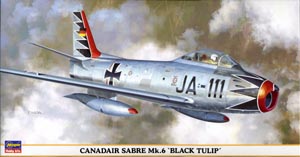 |
Background
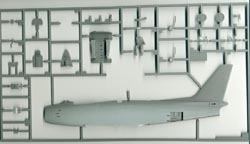 The
North American F-86 Sabre needs no lengthy introduction here. It is by
far the most well-known of the pre-Century Series USAF jets, having won
enduring fame in the Korean War and serving with many nations. The Royal
Canadian Air Force chose the F-86 to meet its day fighter requirements.
Over 1800 Sabres were built under license by Canadair and served with
the RCAF and other air arms as well. Mk 5 and Mk 6 Canadair Sabres were
fitted with the more powerful Orenda engines instead of the General Electric
J-47. The
North American F-86 Sabre needs no lengthy introduction here. It is by
far the most well-known of the pre-Century Series USAF jets, having won
enduring fame in the Korean War and serving with many nations. The Royal
Canadian Air Force chose the F-86 to meet its day fighter requirements.
Over 1800 Sabres were built under license by Canadair and served with
the RCAF and other air arms as well. Mk 5 and Mk 6 Canadair Sabres were
fitted with the more powerful Orenda engines instead of the General Electric
J-47.
The Kit
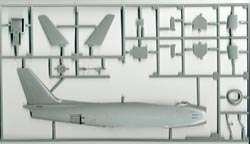 Hasegawa's
1/48th Sabre kits rolled off the production line starting in 1996 with
the F-86F-30. This first release featured the wide-chord "6-3"
wing(leading edge extended 6 inches at the root and 3 inches at the tip).
A later release was the F-86F-40, which had the 6-3 long span wing(wing
tip extensions of 12 inches) and reintroduced the leading edge slats. Hasegawa's
1/48th Sabre kits rolled off the production line starting in 1996 with
the F-86F-30. This first release featured the wide-chord "6-3"
wing(leading edge extended 6 inches at the root and 3 inches at the tip).
A later release was the F-86F-40, which had the 6-3 long span wing(wing
tip extensions of 12 inches) and reintroduced the leading edge slats.
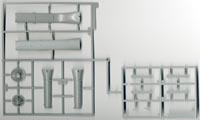 The
Sabre Mk 6 kit is actually the F-86F-40 with instructions to remove the
12-inch wing extensions and attach replacement resin wing tips. This is
correct because the Canadair Sabres were not fitted with the long wings.
A metal replacement pitot tube of the cranked design is also provided
to replace the straight plastic pitot tube. The
Sabre Mk 6 kit is actually the F-86F-40 with instructions to remove the
12-inch wing extensions and attach replacement resin wing tips. This is
correct because the Canadair Sabres were not fitted with the long wings.
A metal replacement pitot tube of the cranked design is also provided
to replace the straight plastic pitot tube.
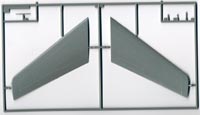 The
kit parts are well-molded and well-detailed with petite engraved lines.
Appropriate raised detail is present in the cockpit parts. No flash or
obvious sink marks are apparent. A pilot figure is included. Two different
drop tank fin arrangements are also provided. The
kit parts are well-molded and well-detailed with petite engraved lines.
Appropriate raised detail is present in the cockpit parts. No flash or
obvious sink marks are apparent. A pilot figure is included. Two different
drop tank fin arrangements are also provided.
Marked "not for use" are the two Sidewinder missiles and
their pylons. This is correct for the "Black Tulip" Sabres of
JG-71, but German Sabres of other units did carry Sidewinders.
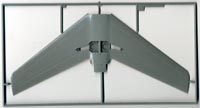 The
kit lacks separate leading edge slats( they droop when the aircraft is
parked), although the lines for them are engraved into the wings. Since
not all Mk 6 Sabres had the slats installed, this may or may not be a
problem--depending on the individual aircraft you are building. According
to my reference photo of JA-111(Erich Hartmann's aircraft), the wing is
a "hard wing" and lacks slats. Another omission is the small
rectangular vent on each side of the fuselage above the wing. The
kit lacks separate leading edge slats( they droop when the aircraft is
parked), although the lines for them are engraved into the wings. Since
not all Mk 6 Sabres had the slats installed, this may or may not be a
problem--depending on the individual aircraft you are building. According
to my reference photo of JA-111(Erich Hartmann's aircraft), the wing is
a "hard wing" and lacks slats. Another omission is the small
rectangular vent on each side of the fuselage above the wing.
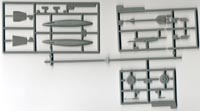 In
order to build an accuarate Mk 6 Sabre, the air intake in front of the
right speed brake well should be removed, and the raised area around the
vent in front of the vertical tail should be removed. This is not mentioned
in the instructions. In
order to build an accuarate Mk 6 Sabre, the air intake in front of the
right speed brake well should be removed, and the raised area around the
vent in front of the vertical tail should be removed. This is not mentioned
in the instructions.
Detail hounds might also want to alter the instrument panel and change
some of the small access panels on the fuselage to more accurately reflect
the Mk 6 Sabre.
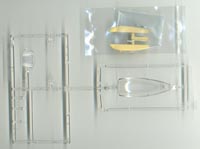 Decals Decals
The high point of this kit is the decal sheet containing markings for
only one aircraft. But the markings are for Erich Hartmann, the highest-scoring
fighter ace of all time. Hartmann was the first commanding officer of
JG-71 "Richtofen", one of the units of the new West German Air
Force formed in the late 1950s. The famous black and white tulip scheme
of Hartmann's WW II BF-109s was born again and applied to the noses of
JG-71 Sabre Mk 6s. Red or yellow(for the first or second squadron respectively)
was painted on the intake and fin leading edge.
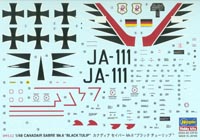 The
comprehensive Hasegawa decal sheet features Hartmann's mount, JA-111.
The modeler still must paint the nose intake ring area red, however. The
marking and painting guide shows both natural metal and camouflaged versions
of this aircraft. The
comprehensive Hasegawa decal sheet features Hartmann's mount, JA-111.
The modeler still must paint the nose intake ring area red, however. The
marking and painting guide shows both natural metal and camouflaged versions
of this aircraft.
Conclusion
Unfortunately, there is no truly accurate 1/48th kit of the Canadair
Sabre. We are left with the task of modifying and adapting existing F-86
kits. Given that fact, the Hasegawa kit is a good starting point. Also,
not many choices are out there in decal land for the Canadair Sabres.
The Canadair Sabre is an overlooked subject with great potential--I hope
that the modeling industry will notice and respond.
Postscript: I highly recommend "The Canadair Sabre " by Larry
Milberry as the best reference book on the subject.
|
|
